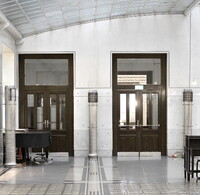Austrian Postal Savings Bank
Wagner, Otto

Download1A1-WO-P-J16_cp.jpg (591.2Kb)
Alternate file
Alternative Titles
Österreichische Postsparkasse
Wagner: Werk Museum Postsparkasse
Date
1903-1906Description
Interior, main banking hall entry doors; The design for the Postsparkasse, one of his best-known works, won a competition (1903) and is based on a logical trapezoidal plan with a banking hall at its centre. The six-storey entrance façade, surmounted by a simple Sezessionstil pergola flanked by winged figures, has large windows set in walls faced with white marble with aluminium fixings. The central space of the banking hall (modified 1980s) had a glass vault of stilted elliptical section carried on riveted steel columns, and a floor with glass lenses to light the basement below; aluminum ventilation bollards ranged around the wall added to the illusion of an industrial aesthetic. The bank owed its atmospheric effect to the impression of silver light produced by glass, aluminum and marble. One of the earliest icons of the Modern Movement, it is contemporary with Frank Lloyd Wright's Larkin Building, pre-dates Peter Behrens's Turbinenfabrik in Berlin by several years and marks the achievement of Van der Nüll's concept of a tradition-driven modern architecture of the future. [The building now houses a museum dedicated to Wagner]. Source: Grove Art Online; http://www.groveart.com/ (accessed 1/26/2008)
Type of Work
bank (building)Subject
architectural exteriors, business, commerce and trade, Secession Movement, Sezessionstil, Modernist, Twentieth century
Rights
Rights Statement
Licensed for educational and research use by the MIT community only